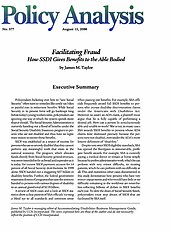Policymakers bickering over how to “save Social Security” often turn to remedies like costly tax hikes or painful cuts in retirement benefits. While Social Security in its present form will go bankrupt long before today’s young workers retire, policymakers are ignoring one way in which the system spends more than it should. The Social Security Administration is currently handing out a flood of benefits under the Social Security Disability Insurance program to persons who are not disabled and thus have no legitimate reason to receive those benefits.
SSDI was established as a source of income for persons who are so severely disabled that they cannot perform any meaningful work that exists in the national economy. The program, which allocates funds directly from Social Security general revenues, was never intended to be as broad and expensive as it is today. Yet current SSDI payments account for 14 percent of all Social Security distr ibutions. In 1999 alone, SSDI handed out a staggering $57 billion in disability benefits. Further, the federal government maintains dozens of programs that raise the amount handed to persons with various degrees of disability to an annual grand total of $110 billion.
A review of SSDI cases and a look at SSDI statistics show a clear pattern of SSA officials’ turning a blind eye to all standards and common sense when passing out benefits. For example, SSA officials frequently award full SSDI benefits to persons who pursue disability discrimination claims under the Americans with Disabilities Act. However, to assert an ADA claim, a plaintiff must argue that he is fully capable of performing a desired job. How can a person be simultaneously able and unable to work? Wor se yet, in many cases SSA awards SSDI benefits to persons whose ADA claims were dismissed precisely because the persons were not disabled, even under the ADA’s more lenient definition of “disability.”
Despite very strict SSDI eligibility standards, SSA has opened the floodgates to innumerable, profligate benefit awards. For example, SSA is currently paying a medical doctor to remain at home simply because he prefers administrative work, which he can perform with very minor difficulty, to treating patients, which he can perform with no difficulty at all. This and numerous other cases documented in this study demonstrate how persons who have very minor impair ments and who would have little or no difficulty remaining in the workforce are never theless collecting billions of dollars in SSDI benefits each year. To slow the drain of Social Security funds, policymakers must stop abuses of SSDI that are facilitated by SSA itself.
About the Author

This work is licensed under a Creative Commons Attribution-NonCommercial-ShareAlike 4.0 International License.
